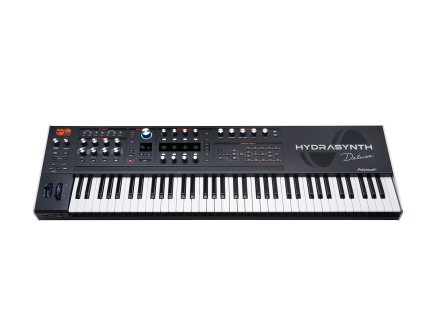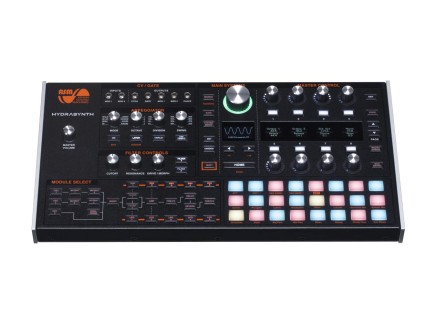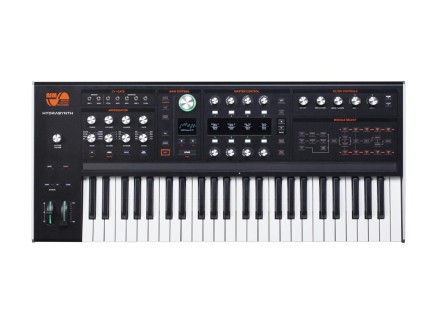It's no secret that we at Perfect Circuit are big fans of ASM's Hydrasynth—and how could you blame us? Now with four different models available, there's a Hydrasynth out there for everyone: the standard keyboard model, the compact and rack-mountable desktop version, the highly-portable and battery-friendly Explorer, and the expansive, bi-timbral Deluxe.
With all of the buzz surrounding the reveal of the Deluxe and Explorer models, we thought it would be fun to spend some time diving into the sound design depths of the Hydrasynth to emerge with a handful of tips to enrich your own patch creation process. Most of these concepts may be exercised on any model of Hydrasynth (with one notable exception), and can serve as a jumping off point for other ideas within the incredibly versatile sound design engine.
If you're curious to try some of these concepts yourself, I've prepared a bank of patches from my personal collection that can be downloaded here. Some of these patches are from the video above, while others explore some different ideas.
Tip #1: Sub-Audio Rate Oscillators
One of the Hydrasynth's main attractions is the extensive selection of single-cycle waveforms that may be loaded into its oscillators. In fact, there are 219 options available, ranging from traditional synthesis waveforms to odd vocal-like sounds and otherwise ethereal timbres. Like a wavetable synthesizer, Hydrasynth reads back waveforms at various speeds across the keyboard, or pads in the case of the desktop model.
When scrolling through the waveforms, it's easy to notice that a number of them have rather complex shapes. Upper harmonics manifest as higher frequency waveforms themselves, and depending on the distribution of partials may cluster together into dense, noisy timbres or appear as discrete, discernible tones. At the extremes, the highest harmonics add sparkle on top of the more tonal portions of the waveform, but by tuning down the fundamental frequency of the oscillators into sub-audio territories, what was once textural becomes the primary component of a sound. Of course, should the lower harmonics still be somewhat audible, lightly applying a highpass filter to your patch will clean up the low-end rumbles.
My process for setting up a patch in this style is fairly straightforward, though it should be understood that our results will be more suited for sound effects and textures, as they forego conventional notes and pitches. First, I like to tune an oscillator down as low as it will go. By default, Hydrasynth lets you tune an oscillator down as far as 36 semitones, or three octaves, below the note being played, but we can push the pitch down even further by applying an envelope or two with maximum sustain as pitch modulation sources with negative depth. This would be equivalent to using a voltage offset generator in the context of a modular patch, which is helpful for something like turning a self-oscillating filter into an LFO, for example.
From there, it's a matter of choosing the right wave shape for your sonic goals. When their fundamental frequency is in the sub-audio range, each waveform has a much different identity than usual, so it's worth spending a moment scrolling through the many options to find something desirable. I generally get the best results with more complicated waveforms, so leaning on choices like the Scorpio, Cluster, and Spect X banks work nicely. Activating Wave Scan mode and smoothly interpolating between waveforms then offers the opportunity to morph through a number of timbres, rhythms, and textures.
Tip #2: Combining Step LFOs with the Arpeggiator
The Hydrasynth sound engine is incredibly vast, and offers a number of ways to apply expressive modulation into patches beyond its five LFOs and five envelopes, via polyphonic aftertouch, external MPE input, and more. While it does have an arpeggiator, one thing that many feel the Hydrasynth is lacking is a dedicated sequencer. However, much like how I consider the Hydrasynth Mutators to challenge my prior notion of synthesis methods like FM and Sync, the Step mode available in the LFOs is ASM's answer to anyone looking for a sequencer.

Available as an option alongside the traditional LFO wave shapes, Step mode allows for the creation of step sequences of up to 64 steps in length. On top of this, activating an option known as SemiLock will quantize these values to chromatic notes, which makes it ideal for setting up pitch sequences. The Step LFO provides a two-octave note range, centered around the note being played and offering 12 notes above and 12 below. By itself, this is a simple way to provide some alternative pitch movement beyond the arpeggiator, but magic begins to happen when you combine the two.
With care put into Step LFO values and played notes while the arpeggiator is active, long and expansive note sequences are easily possible. With consideration placed into how the arpeggiator gate length and release time of the amplitude envelope are dialed in, sequential swells of notes or endlessly percolating streams of notes can extend musical ideas into totally new forms. This is especially true on the Deluxe model, which allows for both layers in Multi mode to use their own arpeggiator independently.
Tip #3: Filter Overdrive Headroom
Fans of distortion and overdrive have plenty to uncover in the Hydrasynth, where there are three different places to dirty up your patches. With the prevalence of rock music, distorted guitars are a familiar concept to many, but applying distortion to a synthesizer has a number of further implications that should be considered. After all, extended range instruments notwithstanding, synthesizers are generally capable of producing a much wider range of notes than a guitar, and the spectral content of a raw guitar signal is much more mellow than basic sawtooth and square shapes, and many of the others found on the Hydrasynth. Because of how flexible the Hydrasynth can be, I'm actually going to touch upon two different considerations to make when using distortion.
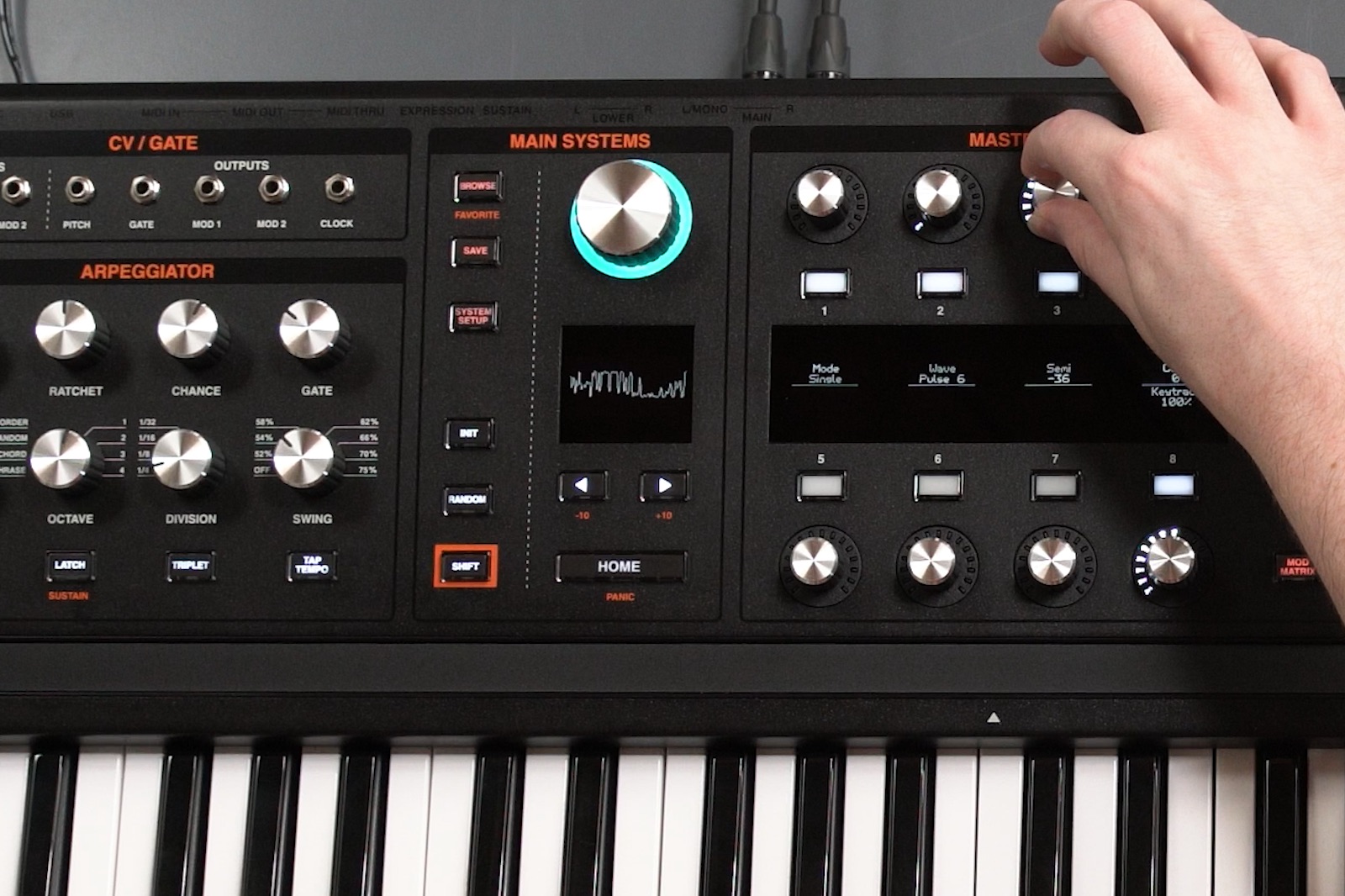
First, let's discuss the nonlinear nature of distortion. Without diving too deep into the field of electronics, a lot of components used in audio devices such as vacuum tubes, transistors, and diodes always contain some level of nonlinear properties which apply some amount of waveshaping that cause an output signal to differ from the input. This relationship is known as a transfer function. In the context of studio monitors and hi-fi listening, finding the sweet spot where signal transfer curves are as linear as possible is crucial to maintaining an accurate image of the audio being amplified for listening. But in other situations, nonlinear curves are incredibly interesting and are responsible for some of the most coveted designs and sounds in preamps, pedals, guitar amplifiers, and more.
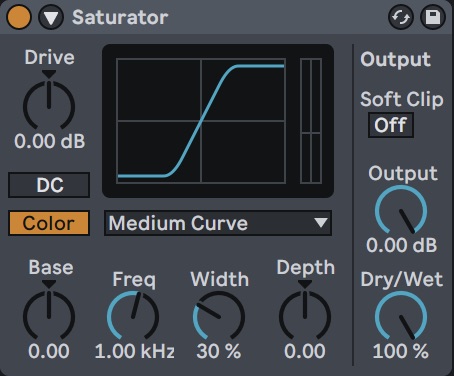 Ableton Live's Saturator device offers a number of transfer curves
Ableton Live's Saturator device offers a number of transfer curves
Because of these nonlinear traits, summing signals with sub-audio frequencies and static voltages before applying saturation is a super fun thing to do in the context of modular patching, as it gives the synthesist direct control over the character of their drive. As you might imagine by discussing this topic in this article, we can do this on the Hydrasynth, too! If we repurpose our first tip, we can use the oscillators in sub-audio ranges for another reason: manipulating the characteristics of the filter drive in a periodic way. Because the Hydrasynth has three oscillators, it's easy to set up a standard, musical patch with one or two oscillators, and reserve the third for this distortion trick.
In this case, I like to turn off keyboard tracking for the super low oscillator, so that the rate of drive modulation is consistent across the range of notes being played. Again, exploring the different waveform options on the oscillators can create a number of different flavors of grit and undulation into the sound, with simpler shapes providing smooth fluctuations, while complex shapes impart noisy textures and sputtery bursts.
Tip #3.5 Distortion and Microtonality
For my other tip on distortion, we're going to draw inspiration from Rob Hordijk, the mind behind instruments such as the Benjolin and Blippoo Box. I recently came across a blog post on his website, which covers a number of topics relating to harmonic distortion. In particular, there's a section where he mentions the implications of tuning with distortion, and thanks to the number of alternative scales and tunings included in the Hydrasynth, this is something that can be explored without much trouble.

As it pertains to the Hordijk article, let us briefly compare equal temperament tuning with just intonation. In Western music history, 12 tone equal temperament (12-TET for short) has been the predominant tuning system since the European classical period, as composers were beginning to be more adventurous with their harmonic progressions. 12-TET allows for the frequency of all notes in the chromatic scale to have an equal relationship with each other, meaning that sequences of chords will sound consistent regardless of which key they were played in, eliminating the need to retune an instrument between performances. This contrasts with practices in the Baroque period as well as numerous traditions in Eastern music, where note relationships were defined in just ratios around a specific tonal center.
These subtle differences in tuning have a substantial impact on the rich harmonics produced by a synthesizer, especially when affected by distortion. If you find your pads or other polyphonic patches to be too abrasive and harsh when drive is applied, it could be that the upper harmonics are being manipulated in such a way that they clash with each other. This should be clearly audible, but it will be easy to notice on the Hydrasynth oscilloscope display as well—playing octaves and fifths should be rather stable, but adding a third or other intervals should bring movement into the sound, a trait Hordijk refers to as intermodulation distortion.

In these situations, it's worth exploring the number of alternative tunings and microtonal options available in the voice menu on the Hydrasynth. Of course, this depends on the musical context as changing tunings will result in other compositional compromises, but for ambient tracks or other sustained forms of electronic music, applying a tuning for specific chords can add cohesion and smooth the edges of your sounds.
Tip #4: Fun with Feedback
Distortion and drive aside, the other sure-fire way to get the most brutal sounds out of your Hydrasynth is to patch up a feedback loop. While the two Mod inputs are primarily used for bringing modular control voltages into the Hydasynth, they're also fully capable of accepting audio input, which can be accessed in a couple of different places within the sound engine. Unfortunately, because the Hydrasynth Explorer doesn't have these inputs, this particular technique isn't possible on that model.

Audio feedback on the Hydrasynth isn't possible internally, at least beyond delay effects and within the Mutators, but making this happen solely requires a 1/4" to 3.5mm cable connecting one of the main outputs to a Mod input. Once that's done, there are two places to inject your feedback loop into your patches: either as an FM source in the Mutators, or as an input in the Ring Modulator. These methods have their own uses and will impart different results onto your sounds, but they can be combined together and used in tandem with the filters and effects found on the Hydrasynth to achieve truly wild results.
When used as a source for FM, feedback can result in periodic frequency manipulations that are perfect for creating interesting sound effects. As with many of these other methods, choice of waveform is key here—cricket-like chirps, controllable disintegration into noise, and so much more is possible. But when bringing feedback into the Hydrasynth through the Ring Modulator, there's a bit more flexibility in how the signal is applied. Of course, it's easy to modulate the incoming audio with an internal source, like an oscillator or a specific output of one of the mutators. But when Ring Mod depth is at zero and the feedback connection in the primary input source, it's possible to bring in the feedback totally dry, thereby giving it direct access to affecting the filter, its drive settings, and the Pre and Post-FX blocks.
Tip #5: Envelope Trigger Sources
Among the many features that have been added to the Hydrasynth over the course of its firmware updates, one that really expands its capabilities as a generative sound source is the ability to define multiple trigger sources for each of the envelope generators. By default, every envelope will be triggered by playing notes, but it's also possible to allow them to be activated by LFOs, ribbon gestures on the keyboard and Deluxe models, pressing a sustain pedal, and the modulation inputs.
This immediately opens up possibilities for lively, self-playing patches or sounds that are incredibly dynamic and responsive to a connected modular system. I personally enjoy assigning slow, asynchronous LFOs as trigger sources, and using the envelope to activate bursts or swells of noise alongside arpeggios or other elements with more defined rhythms, but there's a number of uses for this function in the Hydrasynth sound engine.

Obviously there's a number of other things that can be explored in Hydrasynth sound design, but hopefully these tips will inspire you to try some new techniques or approach patch construction in a different way. There are few synthesizers out there that pack as many sonic capabilities into a single instrument as the Hydrasynth, so it's no surprise that it has been a hit with composers and sound designers. And now with four different models to choose from, there's a good chance that there's a version of the Hydrasynth that could find a home in your own studio.

